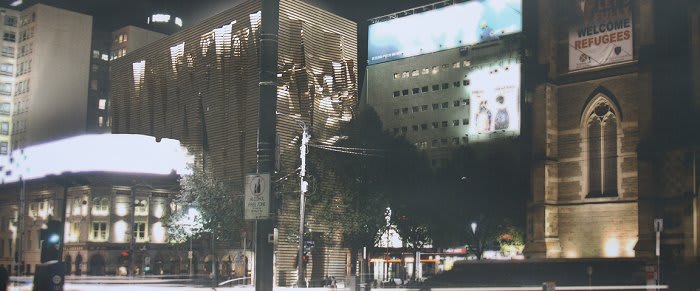RMIT student design - The Museum of Sound
RMIT Student - Zacq Wong
Without exploring the inherent qualities of this design by Zacq Wong, Urban.com.au can't help but be impressed by the ancillary benefits of this conceptional Museum of Sound building located on Swanston Street directly behind Young & Jacksons. Walking out of Flinders Street Station and along Swanston Street is no stroll down the Champs Elysees at the best of times, let alone at night.
For pedestrians and tourists alike, the immediate stretch of Swanston Street from Flinders Street Station isn't a particularly inspiring first-up experience; defined by fast food outlets, cheap souvenir shops and Swanston Street itself which is underutilised, the area requires attention. By implementing a strong institutional or cultural presence in this pocket of Swanston Street along the western flank, one would expect a sizeable boon for the area's urban experience, which coincidentally would complement Federation Square's arts and cultural offerings.
Whether it be a Museum of Sound, a stand alone Indigenous Art and Culture Centre or whatever the case, it would surely lead to a better outcome to what is there presently.
The accompanying project overview reads as follows
Sound Art is a term used to describe art practices that consider wide notions of sound, listening and hearing as its predominant focus. This could be engaged through many possibilities, from the interactive to the contemplative. Sound art - like many other form of visual art, should be experienced in space. Located in the heart of the city, the Museum of sound is a vessel that contains various sound art installations which are showcased in unique environments. The museum consists of a series of five different volumes for showcasing sound installations, spaces for physical sound sculptures and a rooftop performance space which operates at night.
Each sound art volume is designed differently to cater to different uses and types - whether it requires darkness, whether it requires a higher reverb density, or a dead sounding space to a slapping reverb. These volumes provide a simple framework for artists to accommodate or design into. The resonant qualities of sound are explored in the building to provide a unique soundscape and architectural language. The idea of a journey through the museum, with an eventual contrast in lighting and reverb are experienced through vertical movement through the museum.
Externally the Museum of Sound is also what the area requires. Due to a variety of factors the southern end of Swanston Street is akin to the land that time forgot. One glance from the Flinders Street & St Kilda Road/Swanston Street intersection sees a drab mass of precast walls from developments which clearly anticipated further development along the south western side of Swanston Street. Given the area doesn't lend itself to residential of commercial development, the Museum of Sound is exactly what the area requires - bold design that serves a purpose and captures the eye!
Shimmering, undulating and articulate the building both externally and internally fits the bill. Well done to Zacq Wong - if only this concept would become reality.
